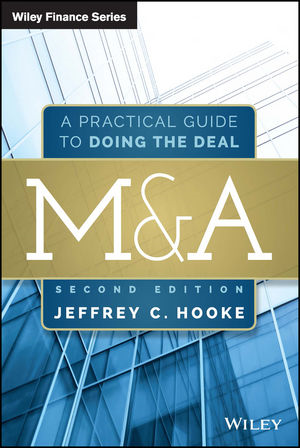
M&A: A Practical Guide to Doing the Deal
Authors:
Jeffrey C. Hooke
Year:
2015
Month:
January
Publisher:
John Wiley
ISBN:
978-1-118-81699-8
The comprehensive M&A guide, updated to reflect the latest changes in the M&A environment
M&A, Second Edition provides a practical primer on mergers and acquisitions for a broad base of individuals numbering in the hundreds of thousands:
· Investment bankers involved with mergers and acquisitions (M&A).
· Equity analysts at hedge funds, risk arbitrage funds, pension funds, and banks, who invest in firms engaged in M&A.
· Private equity professionals at buyout funds, venture capital funds, and hedge funds, who routinely buy and sell companies.
· Corporate executives and business development professionals.
· Institutional loan officers working with M&A and buyout transactions.
· Business students at colleges and graduate business schools.
· Investor relations professionals at corporations and public relations firms.
· Lawyers who work with corporate clients on M&A-related legal, financial, and tax matters.
· Independent public accounting firms that review M&A accounting.
· Government regulators
· Sophisticated individual investors
Its comprehensive approach covers each step in the process, from finding an opportunity, to analyzing the potential, to closing the deal, with new coverage of private equity funds and international transactions. This updated second edition also includes information on emerging markets, natural resource valuation, hostile takeovers, special deals, and more, plus new examples and anecdotes taken from more current events. Additional illustrations and charts help readers quickly grasp the complex information, providing a complete reference easily accessible by anyone involved in M&A.
The mergers and acquisitions environment has changed in the thirteen years since M&A was initially published, creating a tremendous need for authoritative M&A guidance from a banker’s perspective. This M&A update fills that need by providing the characteristic expert guidance in clear, concise language, complete with the most up-to-date information.
· Discover where M&A fits into different corporate growth strategies, and the unique merits it confers
· Delineate clear metrics for determining risk, valuation, and optimal size of potential acquisitions
· Gain deeper insight into the fundamentals of negotiation, due diligence, and structuring
· Understand the best time to sell, the best way to sell, and the process of the sale itself
In the past decade, the dollar value of M&A deals has jumped ten-fold, and the number of individuals involved has expanded considerably. More and more executives, analysts, and bankers need to get up-to-date on the mechanics of M&A, without wading through volume after volume of dense, legalistic jargon. Finally, M&A is back – providing a complete reference to the current state of the M&A environment.
Table of Contents
Preface ix
PART ONE The Big Picture
CHAPTER 1
The Global M&A Market: Current Status and Evolution 3
CHAPTER 2
U.S. M&A History, Trends, and Differences from Other Nations 9
CHAPTER 3
The Need for Growth Spurs Acquirers to Buy Other Companies 15
CHAPTER 4
The Three Financial Tactics That Dominate the M&A Business 25
PART TWO Finding a Deal
CHAPTER 5
The Buyer Must Have a Methodical Plan in Order to Find a Quality Transaction 39
CHAPTER 6
To Begin an Acquisition Search, the Buyer First Sets the Likely Parameters of a Deal 43
CHAPTER 7
The Buyer Starts the Formal Acquisition Search by Alerting Intermediaries and Contacting Possible Sellers 47
CHAPTER 8
Finding a Deal: Likely Results of a Search 59
CHAPTER 9
The Four Principal Risks Facing a Buyer in the M&A Business 65
PART THREE Target Financial Analysis
CHAPTER 10
Sizing Up the M&A Target from a Financial Point of View 77
CHAPTER 11
To Facilitate Financial Projections, the Buyer Needs to Classify the Target as a Mature, Growth, or Cyclical Business 91
CHAPTER 12
How Practitioners Forecast an M&A Target’s Sales and Earnings 97
PART FOUR Acquisition Valuation
CHAPTER 13
The M&A Industry Typically Uses Four Valuation Methodologies 109
CHAPTER 14
The Use of Discounted Cash Flow in M&A Valuation 113
CHAPTER 15
Valuing M&A Targets Using the Comparable Public Companies Approach 123
CHAPTER 16
Valuing an M&A Target by Considering Comparable Deals and Leveraged Buyouts 133
CHAPTER 17
Valuation Situations That Don’t Fit the Standard Models 143
PART FIVE Combination, the Sale Process, Structures, and Special Situations
CHAPTER 18
Combining the Buyer’s and Seller’s Financial Results for the M&A Analysis 159
CHAPTER 19
When Is the Best Time for an Owner to Sell a Business? 167
CHAPTER 20
The Sale Process from the Seller’s Vantage Point 173
CHAPTER 21
A Review of Legal and Tax Structures Commonly Used in Transactions 183
CHAPTER 22
Unusual Transaction Categories 193
CHAPTER 23
Final Thoughts on Mergers and Acquisitions 199
About the Author 201
Index 203
